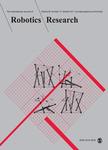版权所有:内蒙古大学图书馆 技术提供:维普资讯• 智图
内蒙古自治区呼和浩特市赛罕区大学西街235号 邮编: 010021

作者机构:Harbin Inst Technol Deep Space Explorat Res Ctr Harbin Heilongjiang Peoples R China Ecole Polytech Fed Lausanne Lausanne Switzerland
出 版 物:《INTERNATIONAL JOURNAL OF ROBOTICS RESEARCH》 (国际机器人研究杂志)
年 卷 期:2019年第38卷第1期
页 面:73-89页
核心收录:
学科分类:12[管理学] 1201[管理学-管理科学与工程(可授管理学、工学学位)] 08[工学] 0811[工学-控制科学与工程]
基 金:National Natural Science Foundation of China (NSFC) [61503102, 61673057] Swiss National Science Foundation START project Swiss National Centre of Competence in Research (NCCR) in Robotics
主 题:Modular robotics optimal reconfiguration computational origami heuristic algorithm
摘 要:Reconfigurability in versatile systems of modular robots is achieved by changing the morphology of the overall structure as well as by connecting and disconnecting modules. Recurrent connectivity changes can cause misalignment that leads to mechanical failure of the system. This paper presents a new approach to reconfiguration, inspired by the art of origami, that eliminates connectivity changes during transformation. Our method consists of an energy-optimal reconfiguration planner that generates an initial 2D assembly pattern and an actuation sequence of the modular units, both resulting in minimum energy consumption. The algorithmic framework includes two approaches, an automatic modeling algorithm as well as a heuristic algorithm. We further demonstrate the effectiveness of our method by applying the algorithms to Mori, a modular origami robot, in simulation. Our results show that the heuristic algorithm yields reconfiguration schemes with high quality, compared with the automatic modeling algorithm, simultaneously saving a considerable amount of computational time and effort.